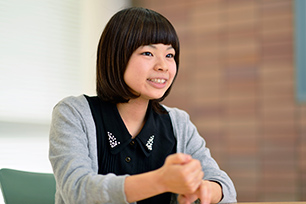The Architecture of Keio University (5)
Broad Learning at the Faculty of Science and Technology Becomes Firm Foundation in the World of Architecture
Fourth-year, Department of System Design Engineering, Faculty of Science and Technology
At Keio University, it is possible to learn and major in many different fields, one of which is of course architecture. We asked one architecture student currently engaged in research at the Faculty of Science and Technology about her experience.
Though there is no department of architecture at Keio University, many aspiring architects study in the Faculty of Science and Technology's Department of System Design Engineering (SD). Once students acquire the necessary number of credits and gain a certain amount of professional experience after graduation, they become eligible to take the national qualifying examination for first-class architects and building engineers (ikkyu-kenchikushi shiken).
Fumika Kake, a fourth-year student in the Department of System Design Engineering, is a member of Prof. Akira Mita's laboratory and well on her way to graduate school to continue her research.
"At our lab, we research the biofication of living spaces. You may well be thinking, 'What on earth is biofication?' Well, just as living beings adapt to changes in the environment to make life easier, our research aims to make advances in the comfort and safety of architecture to better suit the environment. Part of our research activities is developing sensor agent robots. We are trying to create more comfortable living spaces suited to their environments by using robots designed to follow their owners like puppy dogs, all the while gathering various information about their environment. If it's dark, they can turn on the light. If it's hot, they can send a signal to turn on the air conditioner and adjust the temperature. At the lab, we are currently exploring what kind of sensory functions the robot should be equipped with."

At the Faculty of Science and Technology, first-year students choose to enter one of five academic gates of learning and go on to choose one of eleven different departments in their second year. First-year students take classes on a wide range of fields in their gate and decide which specialized department they would like to join before advancing to their second year.(The departments one can join are dependent on the student's gate.)
"In my case, I didn't know what I wanted to learn at university, so it really helped to have a year to learn the basics in a variety of fields before choosing a specific department. Moreover, since system design covers a wide range of learning, I decided that the field of architecture best suited me in my third year after taking courses on control engineering and environment in my second year. Looking back, it was extremely valuable to have the ability to learn a bit of everything in my first and second years. These experiences broadened my horizons, and now I am able to see problems from different perspectives. This ability is sure to come in handy in the future when I start approaching problems in the world of architecture.”
Specialty courses for architecture are divided into three overarching types: structure, design, and building services.
"In courses on structure, we learned to calculate the seismic shaking of buildings in an earthquake; in design, we made models of individual houses and multi-unit housing complexes. For one building services course, I remember using famous architectural works as examples to trace the rise and fall of historical trends. Now I'm interested in lighting, which can be used to make a space feel more comfortable, and other services that can make a space feel cozier."
Fumika also mentions that her favorite architecture at Keio is the East Research Building on Mita Campus: “Its red-brick, collegiate appearance is impressive,” she says. “I was actually a little disappointed to find out that the Faculty of Science and Technology doesn't have classes at Mita (laughs).”
